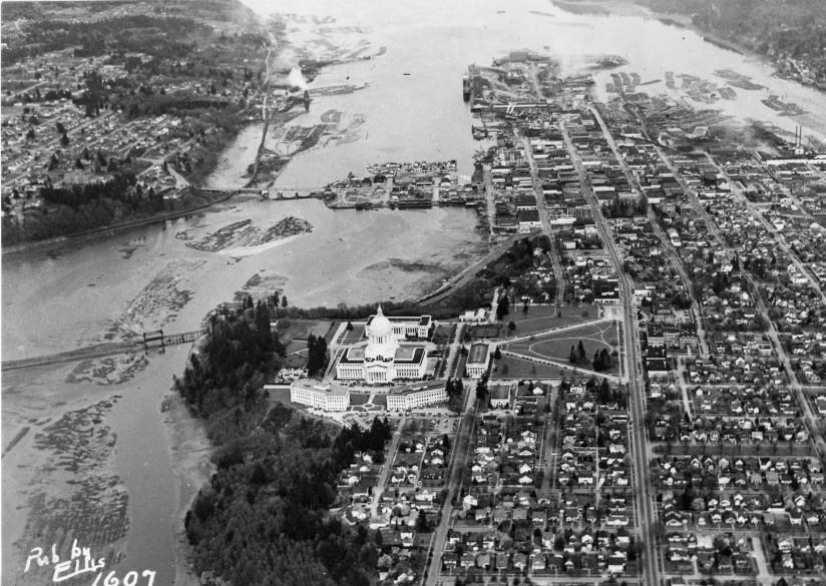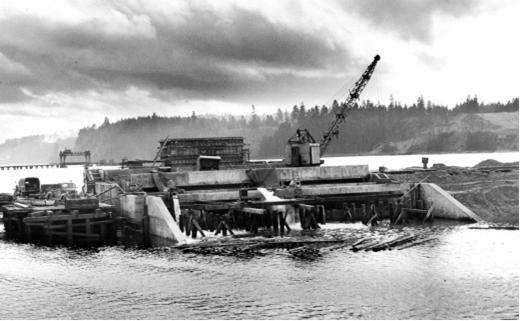History
Time Immemorial
Historically, what is currently known as Capitol Lake was part of the Deschutes Estuary, where freshwater from the Deschutes River would mix with saltwater from Budd Inlet over expansive tidal flats. The Deschutes Estuary has long-standing cultural and spiritual significance to local Tribes, particularly the Squaxin Island Tribe. The Squaxin Island Tribe considers the people and land of the Deschutes Estuary as Steh-Chass. The Steh-Chass village was located on the eastern shore of Budd Inlet in what is today downtown Olympia. Steh-Chass houses and canoes lined the beach, and many Coast Salish groups came to this area to trade.
The Deschutes River and Percival Creek provided fishing and hunting opportunities for salmon, shellfish, and additional resources including beaver, waterfowl, deer, elk, bear, and other animals. The ethnographic record and oral tradition of the Squaxin Island Tribe speak to the importance of this land, its resources, and fishing. This includes ceremonies like the First Salmon Ceremony, which celebrates the first catch of the season and ensures the fish return and remain an abundant resource for future seasons and generations. This project will create preferred salmon habitat and support species recovery.
Continued Use of the Waterbody
The project area has a rich history with historic waterfront communities, maritime industries, and recreational uses. In the early 1900s, Chinatown was established along the waterfront of the estuary, and the community built a series of house boats on the shoreline. This area, later removed to make way for the 5th Avenue Dam, was referred to as Little Hollywood. The Old Olympia Brewing Company operated in Tumwater Historical Park, and vessels would make their way 2 miles up the waterway to the brewery at the base of Tumwater Falls. Olympia Yacht Club was established in its current location in 1912, and the maritime presence has grown increasingly since that time with additional marinas, an active sailing club, and other boat launches nearby. The Port of Olympia was established in 1922 and was a major part of the local timber trade through the 1950s.

5th Avenue Dam Construction
Between 1949 and 1951, a dam was constructed at 5th Avenue and, without the tidal exchange, the area was transformed into a freshwater lake, fed primarily by the Deschutes River. The waterbody was renamed Capitol Lake. Capitol Lake was designed as part of the Washington State Capitol Campus, and it became an important recreational resource to the community until its closure to public access in 2009.

Identification of Need for Long-Term Management
Many of the entities participating in this project have been engaged in long-term management planning for the waterbody for almost 50 years—seeking to resolve environmental issues and to make a decision on a comprehensive management approach. By the early 1970s, backflushing of the waterbody was required to control algal blooms and freshwater plants, and monitoring of water quality and sediment deposition began. By 1975, the volume of sediment deposited in Capitol Lake from the Deschutes River since construction of the 5th Avenue Dam was estimated at over 1,000,000 cubic yards. That volume of sediment is enough to fill approximately 225 to 300 Olympic-size swimming pools.

Intergovernmental efforts continued over the next 40 years, including development of action plans, evaluations of long-term management options, collection of additional environmental data, convening of oversight bodies to implement adaptive management measures, a feasibility study to consider estuary restoration, and more. Additional information on the timeline of key governmental and agency efforts for management of the waterbody can be found in Chapter 1 of the EIS.
Authorization to Re-engage in Long-Term Management Planning
In 2016, DES received an appropriation from the Washington State Legislature to make tangible progress on reaching board agreement on a long-term management plan. In coordination with the Squaxin Island Tribe, governmental and agency partners, and the community, DES identified four primary, shared goals for long-term management of the waterbody. Goals included improving water quality, managing sediment accumulation and future deposition, improving ecological functions, and enhancing community use of the resource.
The goals were established during a collaborative process and there was broad agreement that a long-term management project must be implemented to achieve these goals and improve existing conditions in the project area.
Environmental Impact Statement Process
DES, as the lead agency under the State Environmental Policy Act (SEPA), determined that there were probable significant adverse impacts from construction and operation of a long-term management project. Thus, an Environmental Impact Statement (EIS) was required to evaluate potential significant environmental impacts (and benefits), reasonable alternatives, and mitigation measures that would avoid or minimize adverse impacts or enhance environmental quality. The EIS process, including extensive technical analyses and stakeholder engagement, began in 2018 and concluded in 2022.
The EIS summarized the potential impacts and benefits of three long-term management action alternatives and a no action alternative. It included additional information that was considered in the decision-making process, including planning-level costs, input from engaged governmental and agency partners, and permits and approvals that would be required to implement a preferred alternative. The alternatives included:
- Managed Lake Alternative: Retain the 5th Avenue Dam in its current configuration but with active management to address environmental conditions and restore recreation.
- Estuary Alternative: Remove the 5th Avenue Dam and establish an approximately 500-foot-wide opening to reintroduce tidal flow.
- Hybrid Alternative: Remove the 5th Avenue Dam to reintroduce tidal flow but construct a retaining wall to create an approximately 45-acre groundwater-fed, freshwater reflecting pool adjacent to Heritage Park.
- No Action Alternative: Represents the most likely future expected in absence of implementing a long-term management project.
Following review of more than 850 comments on the Draft EIS and additional analyses, DES and the EIS project team evaluated the alternatives against a range of technical criteria and considered input from engaged stakeholders on the ability of each alternative to achieve long-term support.
The Final EIS was issued on October 31, 2022, and the Estuary Alternative was identified as the preferred alternative for long-term management of the Capitol Lake – Deschutes Estuary. The Estuary Alternative best achieves project goals and had the greatest ability to achieve long-term support.
Design and Permitting
Design and permitting began in late 2023 and is expected to occur over a 3- to 5-year period, assuming additional funding is secured without delay. In this process, all components of the estuary restoration (e.g., habitat areas, dam removal, bridge, and boardwalks) will be designed. DES will obtain permits from federal, state, and local agencies; these are needed before construction can begin. DES will work collaboratively with the Squaxin Island Tribe and other key stakeholders, as well as the community, throughout the design process. Construction is anticipated to take approximately 6 years.
